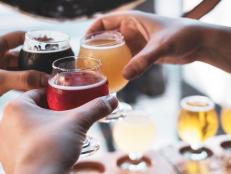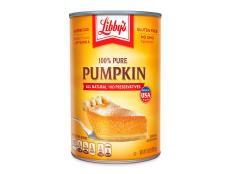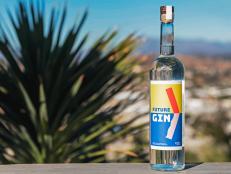Everything You Need to Know About the Favorite Drink of Sober Curious Celebrities
Bella Hadid and Jen Batchelor’s Kin Bloom is set to replace your all-day rosé.


A few years ago, Bella Hadid was looking for ways to recalibrate. Juggling her work and personal life felt unsustainable. “I never really was able to get my anxiety and energy on a controlled level,” she tells me. Eventually, she took it into her own hands to find something that really worked for her. That something happened to be Kin Euphorics, the color aura-decorated cans you’ve probably seen all over your social media feeds (and in the hands of plenty of influencers).
While many of us can’t quite say we live the same lifestyle as Bella Hadid, she isn’t alone in her search for better day-to-day rituals. She was looking for a “healthier and more exuberant life.” (Aren’t we all?)
Founded by Jen Batchelor and Hadid herself, Kin fits into a larger movement toward sober curiosity. In a 2021 NielsenIQ survey, 22% of consumers said they were drinking less, citing fewer opportunities to go out, a waning interest in alcohol in general and a greater desire for wellness and a healthier lifestyle as the top reasons for the cutback. With growing campaigns like Dry January (plus newer Sober October), and lots of interesting low-alcohol and alcohol-free alternatives, the status of booze is shifting from a social default to merely optional. It also doesn’t hurt that sipping on a spirit-free drink for the night now feels a lot less lame.
However, Kin isn’t branded as a simply alcohol-free beverage. The company claims that the cans offer a host of functional benefits. Lightwave promotes “inner peace,” Kin Spritz “social energy” and made-to-mix Dream Light delivers you to deep sleep. Kin’s newest flavor is called Bloom, and “unlocks heart-opening joy any time of day.”
While some of its promises feel more nebulous, the drinks are meant to take the place of alcohol and caffeine, and supposedly reduce stress and anxiety, boost energy and help you open up at parties. All this – minus the jitters and hangovers.
Certainly, this all seems ideal. But really, how do these drinks work? Depending on the flavor, each drink comes with a mix of adaptogens (herbs used in Ayurvedic and traditional Chinese medicine), nootropics (non-prescription substances that can affect thinking, memory and mental function) and botanicals.
It’s important to note that none of the products’ claims (nor their ingredients) have been approved nor endorsed by the U.S. Food and Drug Administration (FDA). For context, several of the vitamins and supplements sitting in drug store aisles are in the same boat – and included in some of Kin’s drinks.
One nootropic found in Bloom, for example, is 5-HTP, an over-the-counter supplement that is said to help boost serotonin levels. 5-HTP has been the subject of ongoing research into whether it can effectively treat mild depression, anxiety, sleep disorders and reduce food intake. According to experts, more research is needed. Keep in mind that, like the coffee you can’t live without (also a nootropic), Kin drinks are too meant to be consumed in moderation – the company recommends no more than four cans within 24 hours. Binge drinking the Bloom variety could potentially lead to serotonin syndrome, a serious drug reaction, says Vanessa Rissetto, registered dietician and co-founder of Culina Health.
Another nootropic, melatonin, can be found in Kin’s Dream Light. Melatonin, which can also be bought as a supplement on its own, is taken as a sleep aid by many people. However, it’s not meant to be used daily or on an ongoing basis. It’s also important to be mindful of when you take it. Kin advises to sip on this only 1-2 hours before sleep. Taking melatonin at random times of the day can mess with your sleep cycle, says Rissetto. Once again, these are drinks that should be consumed with intention, alcohol or not.
When consumed in moderation and under the right conditions (it should not be consumed if you’re under 18, pregnant, taking SSRIs or have a medical condition), these are tonics that can be, in the words of Batchelor, “sexy and delicious to drink.”
Between the offerings, Hadid says, “It’s hard to choose a favorite.” Her mornings tend to start with Kin Spritz – “Coffee out. Kin in. Spritz is a before work, before gym pick-me-up that never lets you miss a beat.”
For bedtime, she reaches for Light Wave, which has “an addicting taste.” Hadid also likes this flavor for active meditations like hiking, ceramics or journaling in the park, “making you sink into a state of calm” and get “in sync with your creativity.”

Photo courtesy of Kin Euphorics
As for Bloom, it’s set to replace your glass of all-day summer rosé. The drink takes after its boozy counterpart with a flavor fusion of juicy strawberries, white grape, spiced barrel oak and rosemary citrus. Developing Kin Bloom took several tries to hone in on a formula that could boast great flavor without sacrificing function, says Batchelor.
Bloom is designed to be “the ultimate energy enhancer.” It leans on a blend of Schisandra, L-Theanine and Damiana, a wild shrub whose leaf and stem can be used to “awaken passion” and “ignite heart’s fire.”
Hadid says Bloom is an “all-day magic kind of drink,” good to have at any point of night or day. “It’s for those days you just want to be out and about, but your aura and energy seem to be low. It’s the perfect roadie to get you into the mood for fun, socializing, love and blooming.”
I got the chance to try the new flavor myself and, function aside, I can attest – it tastes delightful. Like a gently sweet, earthy, grown-up version of strawberry soda. I would drink Bloom for its flavor alone.
Bottom line: Kin can make alcohol-free socializing fun, but it’s important to pay attention to how you feel when drinking them.
In the end, if you decide to give Kin drinks a try, it’s important to take stock of how they affect you. For some, there may be no noticeable effects. But for others, the drinks may work just as one would hope (and yes, it’s possible that the placebo effect plays some role in it). The company says to “consider yourself a key ingredient.” Everyone reacts differently. It’s advisable to talk with a healthcare professional before consuming Kin or other functional beverages.
If nothing else, Kin drinks are prompts to check in with yourself. As someone who also went on a wellness journey of sorts (it’s still ongoing), the mere existence of a just-as-fun, non-alcoholic drink option opens up another set of choices. Do I really want a beer, or do I want to try this cool-seeming thing? Do I need alcohol to have a good time? Will opting out of alcohol make it easier for me to go on that run tomorrow morning? Did this drink even work for me? When you ask yourself these questions, I think you get closer to what wellness is really about – evaluating how your choices affect you, and deciding if you want to make them again.
Editor’s Note: Interview has been edited for length and clarity.
*This article has been reviewed by an independent registered dietitian nutritionist.
Related Content:

































